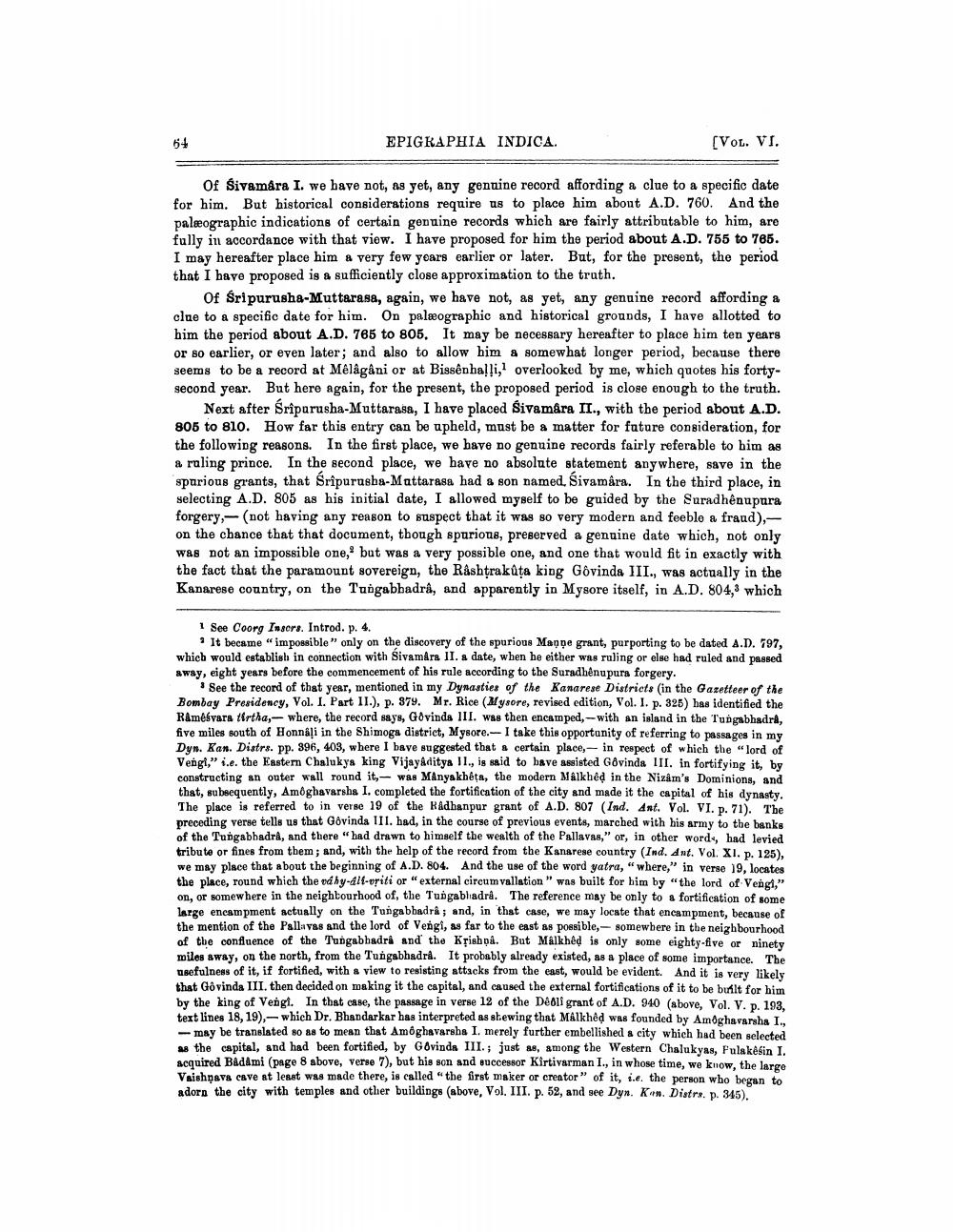________________
EPIGRAPHIA INDICA.
(Vol. VI.
Of Sivamâra I. we have not, as yet, any genuine record affording a clue to a specific date for him. But historical considerations require us to place him about A.D. 760. And the palæographic indications of certain genuine records which are fairly attributable to him, are fully in accordance with that view. I have proposed for him the period about A.D. 755 to 765. I may hereafter place him a very few years earlier or later. But, for the present, the period that I have proposed is a sufficiently close approximation to the truth.
Of Sripurusha-Muttarasa, again, we have not, as yet, any genuine record affording a clue to a specific date for him. On palæographic and historical grounds, I have allotted to him the period about A.D. 765 to 805. It may be necessary hereafter to place him ten years or so earlier, or even later; and also to allow him a somewhat longer period, because there seems to be a record at Mélagani or at Bissenhalli, overlooked by me, which quotes his fortysecond year. But here again, for the present, the proposed period is close enough to the truth.
Next after Sripurusha-Muttarasa, I have placed Sivamara II., with the period about A.D. 805 to 810. How far this entry can be upheld, must be a matter for future consideration, for the following reasons. In the first place, we have no genuine records fairly referable to him as a ruling prince. In the second place, we have no absolute statement anywhere, save in the sparious grants, that Sripurusha-Mattarasa had a son named. Sivamára. In the third place, in selecting A.D. 805 as his initial date, I allowed myself to be guided by the Suradhênupura forgery,- (not having any reason to suspect that it was so very modern and feeblo a fraud), on the chance that that document, though spurions, preserved a genuine date which, not only was not an impossible one, but was a very possible one, and one that would fit in exactly with the fact that the paramount sovereign, the Rashtrakūta king Govinda III., was actually in the Kanarese country, on the Tungabhadrâ, and apparently in Mysore itself, in A.D. 804,which
i See Coorg Inscrs. Introd. p. 4.
. It became "impossible" only on the discovery of the spurious Maope grant, purporting to be dated A.D. 797, which would establish in connection with Sivamira II. a date, when he either was ruling or else had ruled and passed away, eight years before the commencement of his rule according to the Suradhenupura forgery.
See the record of that year, mentioned in my Dynasties of the Kanarese Districts in the Gazetteer of the Bombay Presidency, Vol. I. Part II.), p. 879. Mr. Rice (Mysore, revised edition, Vol. 1. p. 326) has identified the Ráme vara Artha, where, the record says, Govinda III. was then encamped, --with an island in the Tungabhadra, five miles south of Honnási in the Shimoga district, Mysore.--I take this opportunity of referring to passages in my Dyn. Kan. Distrs. pp. 396, 403, where I have suggested that a certain place, - in respect of which the lord of Vengt," i.e. the Eastern Chalukya king Vijayaditya 11., is said to have assisted Govinda III. in fortifying it, by constructing an outer wall round it, was Minyakheta, the modern Málkhed in the Nizam's Dominions, and that, subsequently, Amoghavarsha I. completed the fortification of the city and made it the capital of his dynasty. The place is referred to in verse 19 of the Ridhanpur grant of A.D. 807 (Ind. Ant. Vol. VI. p. 71). The preceding verse tells us that Govinda 111. had, in the course of previous events, marched with his army to the banks of the Tungabhadra, and there had drawn to himself the wealth of the Pallavas," or, in other words, had levied tributo or fines from them; and, with the help of the record from the Kanarese country (Ind. ant. Vol. XI. p. 125), we may place that about the beginning of A.D. 804. And the use of the word yatra, "where," in verse 19, locates the place, round which the vd hy.dll-urili or "external circumvallation" was built for him by "the lord of Vengi," on, or somewhere in the neighbourhood of, the Tungabhadrâ. The reference may be only to a fortification of some large encampment actually on the Tungabhadrâ; and, in that case, we may locate that encampment, because of the mention of the Palla vas and the lord of Vengi, as far to the east as possible,- somewbere in the neighbourhood of the confluence of the Tungabhadra and the Kish på. But Malkhod is only some eighty-five or ninety miles away, on the north, from the Tungabhadra. It probably already existed, as a place of some importance. The usefulness of it, if fortified, with a view to resisting attacks from the cast, would be evident. And it is very likely that Govinda III, then decided on making it the capital, and caused the external fortifications of it to be built for him by the king of Vengt. In that case, the passage in verse 12 of the Deoli grant of A.D. 940 (above, Vol. V. p. 193, text linea 18. 19).-which Dr. Bhandarkar has interpreted as shewing that Malkhed was founded by Amoghavarsh I.
may be translated so as to mean that Amoghavarsha I. merely further embellished a city which had been selected
the capital, and had been fortified, by Govinda III. ; just as, among the Western Chalukyas, Pulakasin I. acquired Badami (page 8 above, verse 7), but his son and successor Kirtivarman I., in whose time, we know, the large Vaishnava cave at least was made there, is called "the first maker or creator" of it, i.e. the person who began to adorn the city with temples and other buildings (above, Vol. III. p. 52, and see Dyn. K . Distre. p. 345).




